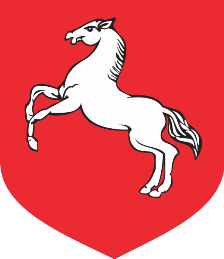
Konin
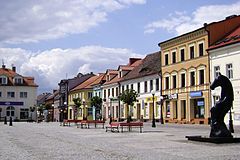 Konin is a city in central Poland, on the Warta River. It is the capital of Konin County and is located within the Greater Poland Voivodeship. Prior to 1999, it was the capital of the Konin Voivodeship (1975–1998). In 2006, the population was 81,233.
Konin is a city in central Poland, on the Warta River. It is the capital of Konin County and is located within the Greater Poland Voivodeship. Prior to 1999, it was the capital of the Konin Voivodeship (1975–1998). In 2006, the population was 81,233.
Prehistory
The earliest evidence of human habitation in Konin has been dated to the Paleolithic Era. On the dunes near the Warta, various ancient flint tools and implements have been found, among them being knives, burins, and tanged points. These earliest artifacts are of the Swiderian culture (Kultura Świderska) of 9000 - 8000 BC.
Ancient times
A permanent settlement arose along the Amber Road, which led from the Roman Empire to the Baltic Sea, traversing the area of present-day Konin. A map drawn by Ptolemy identified the settlement as Setidava (or Getidava), a probable spot to wade across the Warta and containing an emporium of some importance to merchants travelling along the route. The settlement's primary burial ground, situated on the dunes west of the centre of today's Konin, dates back to the Przeworsk culture (Kultura Przeworska) of the 2nd and 3rd centuries AD.
Middle Ages
Toward the end of the early Middle Ages, Gród Kaszuba was the most significant of the fortified settlements near present-day Konin. Inhabited from the 10th through 12th centuries, Gród Kaszuba was situated on the meadows near the Warta. Its abandonment was likely a consequence of floods which damaged its fortifications. The remains of Gród Kaszuba are visible on the south bank of the river.
20th century
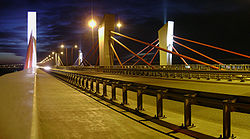
For Konin, the early 20th century was a period of rapid development in the fields of culture, education, and social life. The Musical Society of Kalisz (Towarzystwo Muzyczne w Kaliszu) had as many as 72 members in Konin,[10] and Konin's Jewish Library was one of the finest within the Gubernya of Kalisz, with a quantity of books and a general readership that significantly exceeded similar libraries in Kalisz, a much larger urban area. Also, a branch of the Rowing Club of Kalisz (Kaliskie Towarzystwo Wioślarskie) was founded in Konin in 1908 and, by 1914, had 95 members. Its building, displaying the club's coat of arms, still stands in Old Konin, in Zofii Urbanowskiej Street.
Workers' associations were also established in Konin. In 1905, when significant strikes occurred in Polish industrial centres such as Warsaw and Łódź, there were some minor strikes and turmoil in Konin as well.
A branch of the Polish gymnastic society, Sokół, was founded in Konin. A quasi-military association, its objective was to maintain the fitness of teenagers, to improve their health, and to provide for readily trainable military recruits in the event of a possible national uprising or a defense need. Similar Jewish and German associations also existed.
After the outbreak of World War I in 1914, battles between Russian and Prussian troops occurred near Konin. Ultimately, the city came under Prussian control and deteriorated. The economic situation of the town did not improve when, in 1918, Poland regained its independence (see: Second Polish Republic) in the war's aftermath. Living conditions of residents were still miserable, exacerbated by the lack of functioning water distribution and sewer systems. The subsequent inter-war econonomic crisis was harsh, and conditions did not begin to improve until the désenclavement of the town, attributable to the opening of a major railway, between Poznań and Warsaw, and the construction of a canal to Gopło Lake.
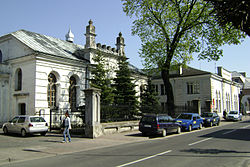 Jews had represented 30% of Konin's population prior to the Second World War. During the war, Konin was part of the land annexed by Nazi Germany (Reichsgau Wartheland). In the town's surrounding forests, the Nazis carried out mass executions of Poles, mostly Jews. In August 1943, the Jews at the labour camp at Konin, led by Rabbi Joshua Moshe Aaronson, burned down the huts in the camp and tried to escape. Almost all of them were killed. The town survivors published, in 1968, an extensive "Yizkor Book" (803 pages) in memory in the flourishing Jewish community: Mendel Gelbart, ed., Kehilat Konin: Bi-Feriḥatah uve-hurbanah (Tel Aviv). The book was written in Yiddish, Hebrew and English. A descendant of Konin Jews, Theo Richmond, wrote Konin: A Quest, the most extensive history of Jewish life in the town ever to appear in English. The majority of Jews in Konin were Mitnagdim, though two small communities of Hasidim lived within the Konin Jewish community, mostly adherents to Gerer Hasidism, with a small group of Aleksander Hasidim.
Jews had represented 30% of Konin's population prior to the Second World War. During the war, Konin was part of the land annexed by Nazi Germany (Reichsgau Wartheland). In the town's surrounding forests, the Nazis carried out mass executions of Poles, mostly Jews. In August 1943, the Jews at the labour camp at Konin, led by Rabbi Joshua Moshe Aaronson, burned down the huts in the camp and tried to escape. Almost all of them were killed. The town survivors published, in 1968, an extensive "Yizkor Book" (803 pages) in memory in the flourishing Jewish community: Mendel Gelbart, ed., Kehilat Konin: Bi-Feriḥatah uve-hurbanah (Tel Aviv). The book was written in Yiddish, Hebrew and English. A descendant of Konin Jews, Theo Richmond, wrote Konin: A Quest, the most extensive history of Jewish life in the town ever to appear in English. The majority of Jews in Konin were Mitnagdim, though two small communities of Hasidim lived within the Konin Jewish community, mostly adherents to Gerer Hasidism, with a small group of Aleksander Hasidim.
Architectural landmarks
Konin County (Powiat Koninski) contains examples of the following architectural forms: Romanesque, Gothic, Renaissance, Mannerist, Baroque, and Rococo; 18th century Classicism; 19th century Neogothic, Neoromanesque, Neoclassicism, and Eclecticism; and 20th century Modernism, Nazi architecture, Socialist Realism, and Postmodernism. Also near Konin are the remains of the reinforced concrete bunkers employed by Poland's Armia Poznań during World War II.
Architecturally, the city of Konin is divided into two historical parts - Old Town (Stary Konin), situated on the south bank of the Warta; and New Konin (Nowy Konin), spreading northward from the river and developed primarily after 1945.
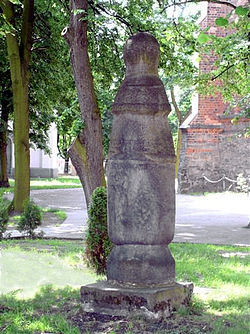
- The Stone Signpost of Konin is the oldest European signpost beyond the boundaries of the Roman Empire. Made of local sandstone from the quarry near Brzeźno, it was commissioned in 1151 AD by either Duke Piotr Włost Włostowicz or Piotr Stary Wszeborowic. Containing Romanesque inscriptions, some scholars hypothesize that the stone itself was originally a Celtic sculpture.
- St Bartholomew's Parish Church is Konin's most notable example of Gothic architecture and art. It contains a gothic net and vault inside the church and stained glass in the chancel.
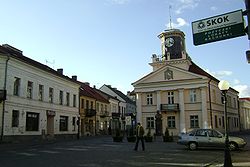 - The Town Hall, built at the beginning of 19th century, has a façade encompassing four, tall Toscany Columns bearing a large pediment. Above the pediment is a small tower with a clock and a tall flagstaff from which the official flag of Konin is hung on local and state holidays.
- The Town Hall, built at the beginning of 19th century, has a façade encompassing four, tall Toscany Columns bearing a large pediment. Above the pediment is a small tower with a clock and a tall flagstaff from which the official flag of Konin is hung on local and state holidays.
Polish Tourist and Sightseeing Society
Perhaps owing to Konin being located at the junction of some of Poland's most historic lands - Greater Poland, Cuiavia, Mazovia, and Łódzkie - the local branch of the Polish Tourist and Sightseeing Society is very active. Moreover, the interest of non-Poles is piqued by the traces of, and monuments to, the many national minorities who have lived over the centuries in Konin and Konin County: Jews, Scots, Germans, Frenchmen, Russians, Romanis, Czechs, Swiss, Dutch Olędrzy, Vietnamese, Chinese, Romanians, and Africans.
Notably, Konin was one of towns along the Scottish Trail - the route through urban areas of Greater Poland and Lower Silesia that connected the various Scottish trading communities that settled in Poland from the 15th century onward.
WWW: konin.pl






.jpg&width=156&height=69&cache_dir=cache)
.jpg&width=156&height=69&cache_dir=cache)

.jpg&width=156&height=69&cache_dir=cache)













